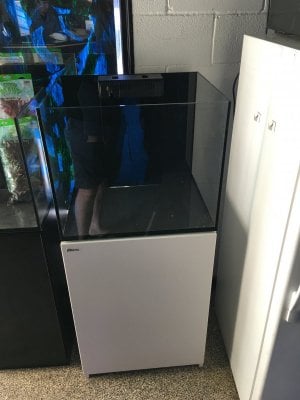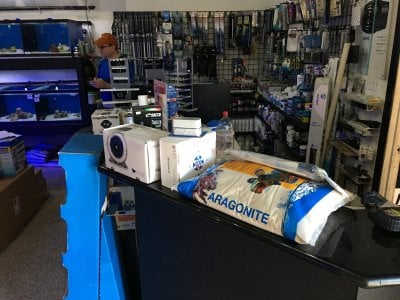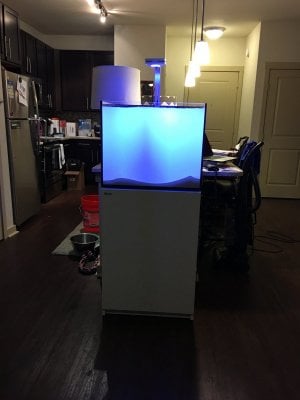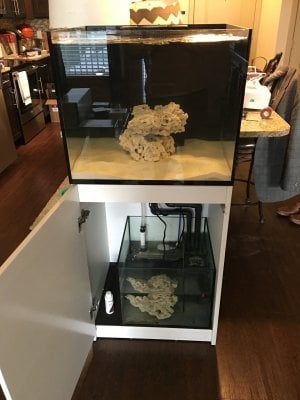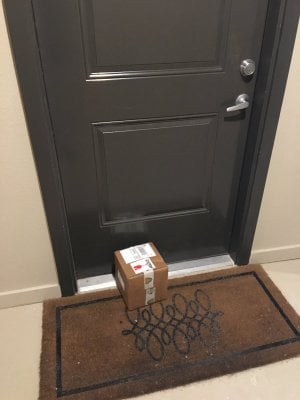Today I wanted to share with you all our newest tank build. We have recently purchased and set up a Red Sea Reefer 170, 43gal Reef tank. In this tank we plan to ultimately keep four mandarins and SPS corals using only AlgaeBarn Live Copepods & Phytoplankton. We hope this thread and our new YouTube Channel, AlgaeBarnTV will become a reference for those seeking to successfully keep Mandarin Dragonets and coral in a reef tank.
The Tank:
I started by heading to our favorite LFS and selecting the ideal aquarium to suit our needs. The tank we decided to go with is the Red Sea Reefer 170. This is a 43gallon tank with many attractive features for anyone from a first time saltwater aquarist to a seasoned expert.
Some of the key features that attracted us to this tank were:
-Rimless glass aquarium style
-Custom fit and water resistant stand (available in white or black)
-Built in overflow filtration
-Built in compartmentalized glass sump with interchangeable filter socks
-Built in auto top off float switch (more on how we modified this later)
-Quiet operation (this tank runs very quiet)
Equipment:
We also picked up some other necessities from the LFS.
For this tank, we decided to go with the following equipment:
-EcoTech Vectra M1 Return pump
-Aqua Illuminations Prime LED aquarium light
-Bubble Magus Curve 5 protein skimmer
-CaribSea South Seas Pukani Dry Rock (40lbs)
-CaribSea Oolite sugar size dry sand (20lbs)
-Fluval E Series 100watt aquarium heater
-Boyd Chemi-pure elite 15oz
-Red Sea Reef Mature Pro Supplement Kit
-Marineland Maxi-Jet 400 (for saltwater mixing)
-Bulk Reef Supply 75gpd 4 stage RODI Unit
-Drs.FosterSmith Live Nitrifying Bacteria
-(2x) Red Sea Reefer 225micron filter socks (ill explain later)
-Mag Float Glass cleaner
-Lee's 25ft Aquarium Gravel Vac kit
-AquaScraper aquarium cleaning tool
-5gal bucket for water mixing
Over time we will add these items to complete the set up:
-Apex Reef Controller
-BRS 2part calcium and alkalinity doser pumps
-BRS biopellet reactor
-MP10 powerhead (if we need more flow, the Vectra should handle it though)
Tank Set Up:
Next we went to Home Depot, rented a truck and began the mad dash to move the tank from the LFS to my living room all within the first hour of having the truck (The first hour in a home depot truck is only $20).
I chose a central location for the tank because I have an island in the middle of my kitchen with a GFI power outlet (important!) and this location allowed me to easily run the RO water line to the tank from under the kitchen sink for a continuous and fully automated top off system. I also considered how much direct sunlight would be on the tank (ideally not a lot.)
Once I decided where I wanted the tank, I grabbed a beer and thought about it some more. You'll want to be absolutely sure this is where you want the tank BEFORE you fill it what the heck water. Once the water is in, it becomes much harder to change your mind. Eventually I decided this was the spot for my new tank and I began the set up and made a video about it.
The Cycle:
After the tank settled (about a day), I began using the Red Sea Reef Mature Pro Kit. This kit contains four essential supplements that will greatly increase the rate at which you can cycle I tank. We followed this kit using the very detailed instruction manual that comes with it. Using this kit we actually were done with the nitrogen cycle in about seven days. I kept a tank log of all of my testing throughout the process so that I could monitor the cycle and know what stage I was in. On day seven of the cycle, I added some AlgaeBarn Poseidon's Feast Live Copepods. I added two 16oz bags of Poseidon's Feast because each 16oz portion is designed to seed approximately 25gal of tank water. I also began dosing AlgaeBarn's OceanMagik Live Phytoplankton blend in order to keep the copepods fed (this is especially important during the initial cycle period because there is no detritus or fish waste for the copepods to feed on, you do not want to starve the pods, so don't skimp on the phyto).
Why did we dose the copepods and phyto this early? Copepods are actually very hardy organisms. In the wild they they get stuck in tide pools where the temperature and salinity can change rapidly. This means they have evolved to be very resistant to changes in water chemistry. Additionally, copepods can survive in high levels of ammonia and nitrite like those usually found during the cycle of a marine aquarium. Copepods actually produce pure ammonia as waste so by adding them to the tank we introduced a natural ammonia source to the aquarium which is necessary for the nitrifying bacteria to continue to establish themselves in the aquarium. Therefore, we can use the copepods, instead of some poor fish, to complete a more humane, fish-less cycle of our reef tank. The phytoplankton ensures that the copepods will always have a food source available so they can fully establish themselves in the aquarium.
So far, the cycle is going very well and we are pretty much ready to add fish. I will be posting a new video to our YouTube channel later this week so be sure and subscribe there to stay up to date on our progress.
I have also added a BRS biopellet reactor, two BRS lab grade dosers for Calc and Alk all controleld by an Apex Jr with the pH probe module add on. I will be connecting the Apex Jr to my WiFi network once the WIFI adaptor comes in!
Im very excited to be able to share this tank with all of you and please do not hesitate to ask me any questions you may have about my technique and methods. I will be updating this thread regularly. Thanks for reading!
Lan
Last edited:


